|
Summary: Sky watchers who saw
it will never forget it: the 2001 Leonid meteor storm.
The display began
on Sunday morning, Nov. 18th, when Earth glided into a dust cloud shed by comet Tempel-Tuttle in 1766. Thousands
of meteors
per hour rained over North America and Hawaii. Then, on Monday
morning Nov. 19th (local time in Asia), it happened again: Earth
entered a second cometary debris cloud from Tempel-Tuttle. Thousands
more Leonids then fell over east Asian countries and Australia.
Page
1 | This is Page 2 | Page
3 | Page 4 | Page 5 | Page
6
All images below
are copyrighted by the photographers.
Some of the videos in this collection appear in RealPlayer
format.
|
|
Photographer, Location |
Images |
Comments |
 |
Dennis Mammana,
Mt. Laguna, east of San Diego, CA, USA
Nov. 18 |
#1,
#2, #3,
#4, more |
D. Mammana: "Even through a variable level
of (sometimes thick) cirrus clouds, meteors burst overhead bright
enough to record on film. A variety of cameras were used--all
guided--and all were shot on Kodak P-1600 film." |
 |
Lyndon Anderson,
near Bismarck, ND, USA
Nov. 18 |
#1 |
L. Anderson: "I took this photo at 12:30
a.m. (CST) on November 18, 2001. I could see a very, very weak
display of the northern lights to the northeast, and so
aimed my camera in that direction. There is a meteor running
right up to some clouds and also, towards the top left, a
debris train from a meteor a few seconds earlier. " |
 |
Stan Richard,
Blue Earth, Minnesota, USA
Nov. 18 |
#1,
more |
S. Richard: "A huge fireball startled me
like a flash of lightning almost directly overhead between 4-5am
CST; I quickly turned the camera straight up and caught what
was left of the flourescent green smoke trail, upper level winds
starting to blow it apart but it lasted for several minutes,
also caught a faint meteor below it. This is cropped from the
original print." |
|
[movie] |
Jayme Hanzak,
North Carolina, USA
Nov. 18 |
RealPlayer format: #1 |
J. Hanzak: ""My video camera was on
a tripod looking in the direction of the Big Dipper. The stars
move due to Earth's rotation. There are several Leonids in this
21 minute movie; the smoky debris from one took 10 minutes to
dissapate." " |
 |
Jim
Fakatselis, Peconic Dunes County Park, Eastern Long Island,
NY
Nov. 18 |
#1 |
J. Fakatselis: "The fireball occurred at
the very start of the exposure, while the smoke trail accumulated
over the 10 min exposure." Photo details: Olympus OM-1 camera,
50mm f/1.4 lens, stopped to f/2.0, through a minus violet filter.
Fuji 800 film. |
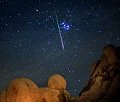 |
Walter Pacholka,
Joshua Tree National Park, CA, USA
Nov. 18 |
#1,
#2, more |
W. Pacholka: "This
brilliant Leonid meteor is streaking below Sirius, the brightest
star in the sky. Another
Leonid races by the Pleiades." Photo details: 35mm camera
with std 50mm lens on a tripod. |
 |
Ethan Hansen,
near Portland, OR, USA
Nov. 18 |
#1 |
A pair of meteors with colors filtered through
a high level haze. Photo details: Nikon D1x digital camera, 17mm
f/2.8 lens, 30 second exposure at ISO 320. |
 |
Doug Murray,
West Palm Beach, FL, USA
Nov. 18 |
#1 |
D. Murray: "I took 6 rolls of film and ended
up with 50+ frames of Leonids. What a show! " |
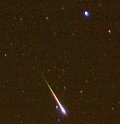 |
David Johnston,
Gold Bar, Washington, USA
Nov. 17 |
#1,
more |
D. Johnston: "This 30 second exposure shows
one bright and 3 fainter meteors radiating from Leo, ~3am Nov
18th. Great night! Photo details: Nikon D1x, 30-sec, f2.8, 400
ISO, 24mm." |
 |
Mark Vornhusen,
Bavaria, Germany
Nov. 18 |
#1,
#2, #3,
#4, #5 |
M. Vornhusen: "I used 50mm and 35mm lenses
and Fuji 1600 print film to capture these pictures of the debris
from several fireballs over Germany." |
 |
Dave Longley,
Syracuse, NY, USA
Nov. 18 |
#1,
#2, #3 |
Photo details: Fuji 800 film with a Minolta 35
mm camera; F 1.7 with exposure generally around 15 seconds. |
 |
Alain-Pierre
Hovasse, north of Toronto, Ontario
Nov. 18 |
#1, more |
A-P Hovasse: "This was taken in the countryside
near Toronto. Shot it on film 400 ASA, F2.8 shutter open for
2 or 3 minutes. There were some kids cheering in the dark away
from us, and a pack of coyotes joined in as well. " |
 |
Joe
Coyle, Flagstaff, AZ, USA
Nov. 18 |
#1 |
J. Coyle:"This photo was taken with a Nikon
F2, Nikkor 24mm lens at f:2.8, about a 30 second exposure not
guided, Kodak Gold 800 not pushed. It shows Sirius (lower left)
Jupiter at the top, Saturn and Aldebaran (right center) and the
constellation Orion with a Leonid just above and left of Betelgeuse." |
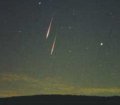 |
Doug Coy,
Colebrook Reservoir, Colebrook, CT, USA
Nov. 18 |
#1 |
Photo Details: Nikon F100 with Kodak max 800
film, 24mm lens, exposure f3.5 for 1 minute |
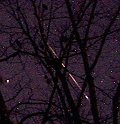 |
Rick Teichman,
New Jersey, USA
Nov. 18 |
#1 |
Photo Details: Kodak DC120, 1 megapixel camera,
16 second exposure. |
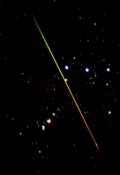 |
Farley
Bridges, Livingston, LA USA
Nov. 18 |
#1 |
A rainbow Leonid! Photo Details: 12 sec exposure
@ f/1.8 taken with tripod mounted Canon F-1 w/ 50mm lens. |
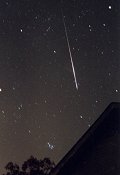 |
Sam
Hall, Chattanooga, TN, USA
Nov. 18 |
#1 |
S. Hall: "This is the best and brightest
Leonid from my first attempt at catching one on film." Photo
details: Fuji Superia 800 ISO, F4.2, Nikon 8008 camera |
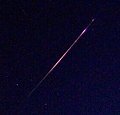 |
Glenn
Sneddon, Melbourne, Australia
Nov. 18 |
#1 |
Photo details: Kodak DC4800 digital camera set
to ASA400 for 15 seconds. |
 |
Alan Stankevitz,
near Nashville, Tennessee, USA
Nov. 18 |
#1 |
A. Stankevitz: "The ionized train from this
meteor persisted for more than 20 minutes; it expanded in size
and moved south during that time." |
More images (click on the name of the photographer
to view the image):
J. Scott Langworthy
(Lake George, New York); Gary
D. Smith (Norwich, NY)
back
to spaceweather.com |
















